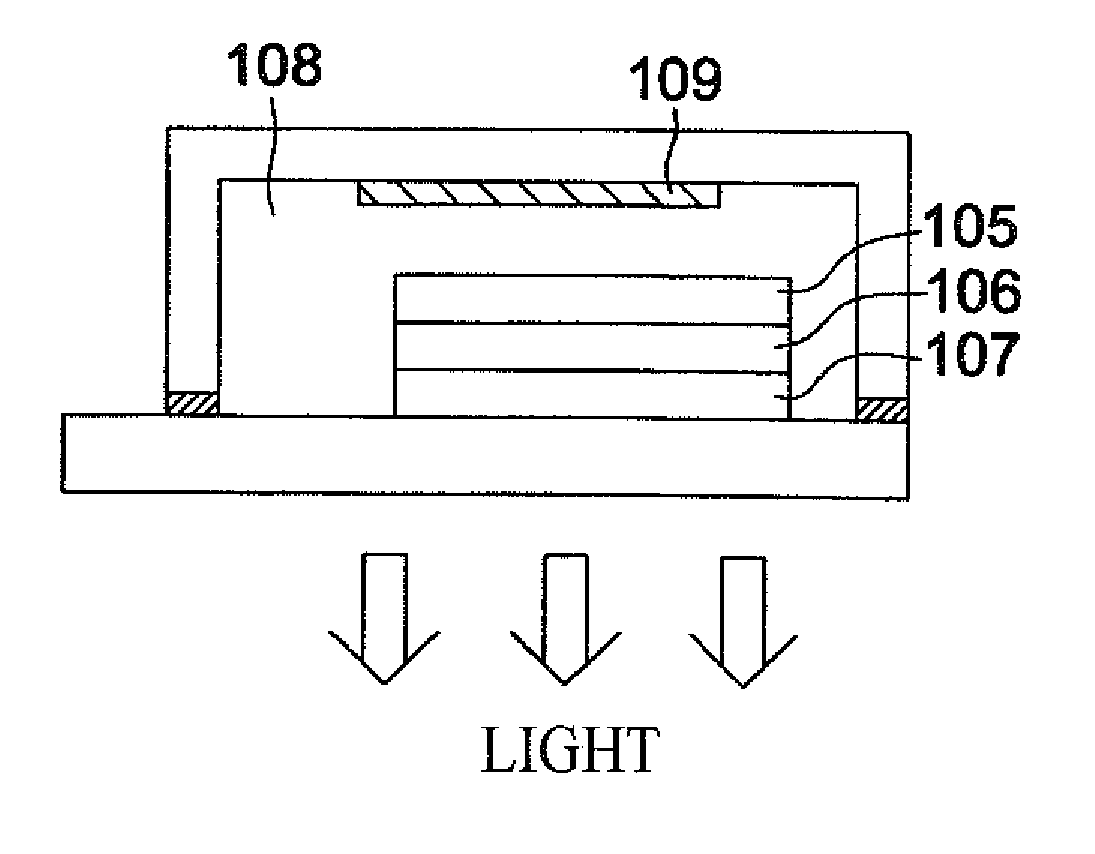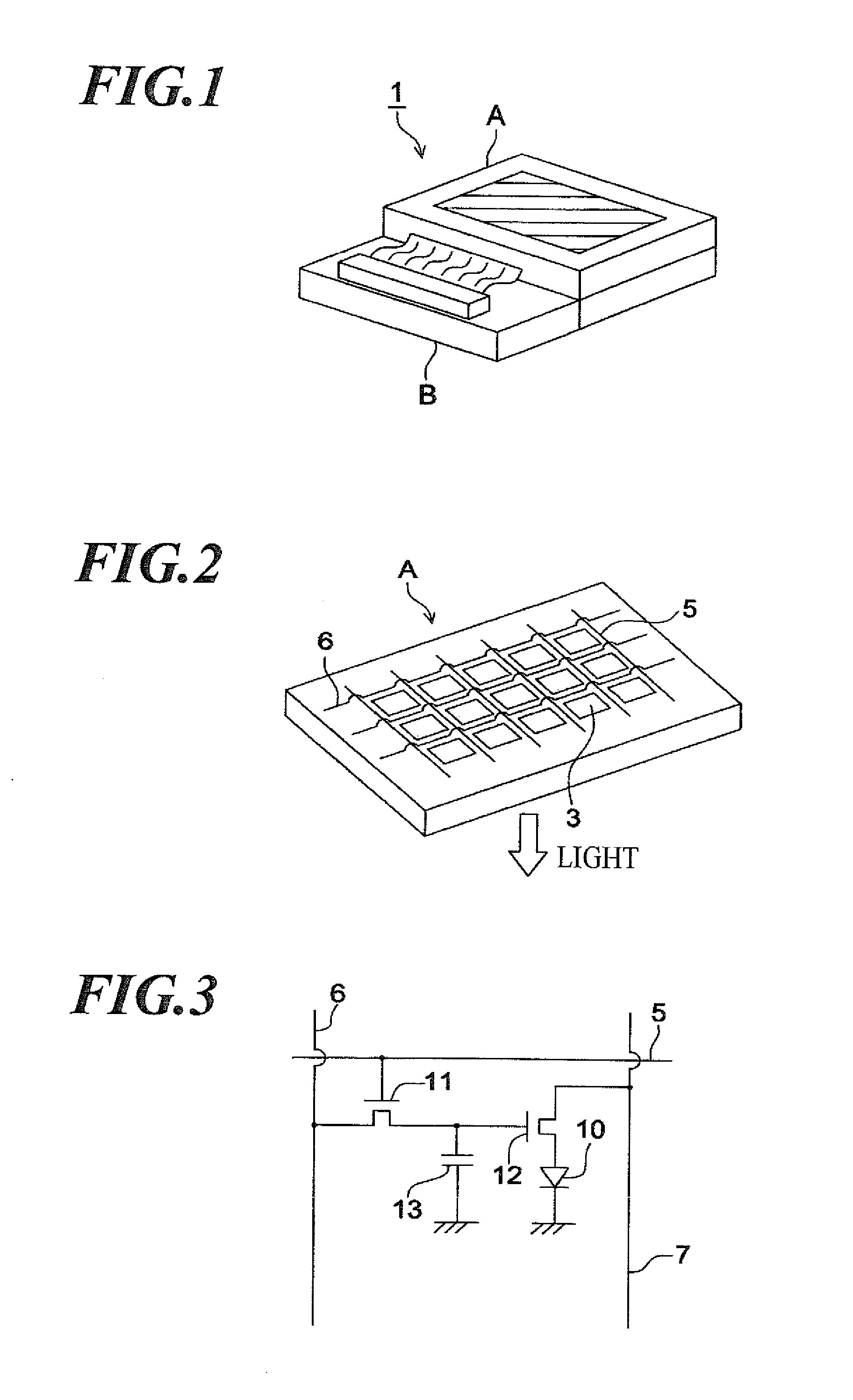Organic electroluminescent device, display apparatus, and lighting apparatus
a technology of electroluminescent devices and display devices, applied in the direction of luminescent compositions, thermoelectric devices, chemistry apparatus and processes, etc., can solve the problems of limited luminescent lifetime, shallow homo, and failure to achieve satisfactory levels of performance of electroluminescent devices using dopants, etc., to achieve long luminescent lifetime, high luminescence efficiency, and low voltage
- Summary
- Abstract
- Description
- Claims
- Application Information
AI Technical Summary
Benefits of technology
Problems solved by technology
Method used
Image
Examples
example 1
(1) Manufacturing of Organic EL Devices
[0315](1.1) Manufacturing of Organic EL Device 1-1
[0316]Structures of compounds used for manufacturing of the organic EL device are shown below.
[0317]A 100-nm-thick ITO (indium tin oxide) film formed on a 100 mm×100 mm×1.1 mm glass substrate (NA-45, from AvanStrate Inc.) was patterned to form an anode. The thus-obtained transparent support substrate, having the ITO transparent electrode patterned thereon, was then subjected to ultrasonic cleaning in isopropanol, dried with dry nitrogen gas, and subjected to UV-ozone cleaning for 5 minutes.
[0318]On the transparent support substrate, a solution of poly(3,4-ethylenedioxythiophene)-polystyrene sulfonate (PEDOT / PSS, Baytron P VP A14083, from Bayer AG) diluted 70% with pure water was spread by spin coating, and then dried at 200° C. for one hour, to thereby form a first hole transport layer of 30 nm thick.
[0319]On the first hole transport layer, a chlorobenzene solution of poly(N,N′-bis(4-butylphenyl...
example 2
(1) Manufacturing of Organic EL Devices 2-1 to 2-12
[0341]Organic EL devices 2-1 to 2-12 were respectively manufactured similarly to the organic EL device 1-1, except that the host compound OC-11 and the comparative dopant compound 1 in the luminescent layer were replaced by the compounds listed in Table 2.
(2) Evaluation of Organic EL Device 2-1 to 2-12
[0342]The thus-obtained organic EL devices 2-1 to 2-12 were evaluated after being respectively sealed and incorporated into a lighting apparatus illustrated in FIG. 5 and FIG. 6, similarly to the organic EL devices 1-1 to 1-15 in Example 1.
[0343]Next, evaluations below were conducted.
[0344](2.1) External Extraction Quantum Efficiency (Also Simply Referred to as “Efficiency”)
[0345]Evaluation was conducted similarly as described in Example 1. The external extraction quantum efficiency was expressed by relative values assuming that of the organic EL device 2-2 (Comparative Example) as 100.
[0346](2.2) Dark Spot
[0347]Each organic EL device ...
example 3
(1) Manufacturing of Organic EL Devices
[0353](1.1) Manufacturing of Organic EL Device 3-1
[0354]A 100-nm-thick ITO (indium tin oxide) film formed on a 100 mm×100 mm×1.1 mm glass substrate (NA-45, from AvanStrate Inc.) was patterned to form an anode. The thus-obtained transparent support substrate having the ITO transparent electrode patterned thereon was then subjected to ultrasonic cleaning in isopropanol, dried with dry nitrogen gas, and subjected to UV-ozone cleaning for 5 minutes.
[0355]On the transparent support substrate, a solution of poly(3,4-ethylenedioxythiophene)-polystyrene sulfonate (PEDOT / PSS, CLEVIOS P VP A14083, from H.C. Starck, Inc.) diluted 70% with pure water was spread by spin coating at 3000 rpm for 30 seconds, and then dried at 200° C. for one hour, to thereby form a first hole transport layer of 20 nm thick.
[0356]The transparent support substrate was fixed to a substrate holder of a commercially-available vacuum deposition apparatus. 200 mg of α-NPD was placed ...
PUM
 Login to View More
Login to View More Abstract
Description
Claims
Application Information
 Login to View More
Login to View More - R&D
- Intellectual Property
- Life Sciences
- Materials
- Tech Scout
- Unparalleled Data Quality
- Higher Quality Content
- 60% Fewer Hallucinations
Browse by: Latest US Patents, China's latest patents, Technical Efficacy Thesaurus, Application Domain, Technology Topic, Popular Technical Reports.
© 2025 PatSnap. All rights reserved.Legal|Privacy policy|Modern Slavery Act Transparency Statement|Sitemap|About US| Contact US: help@patsnap.com



